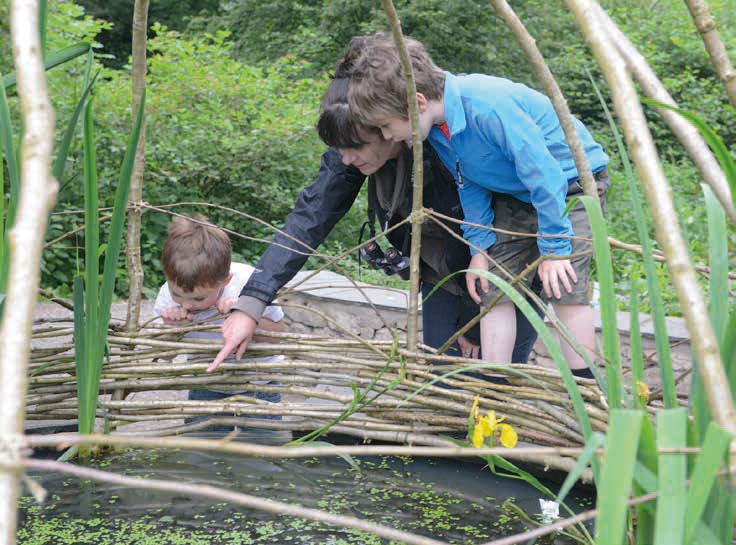Nature Reserve
Morecambe Bay is justifiably renowned across the globe for its dramatic landscapes and famously awe-inspiring sunsets. Its vast and wild vistas have drawn people to the region for generations.
But it isn’t just people who flock to this hidden idyll; the Morecambe Bay area is also one of the most significant sites in Europe for several species of birds as well as providing a home for other scarce and spectacular wildlife.

JON CARTER FROM THE RSPB, NEAR SILVERDALE, EXPLAINS WHY THIS REGION HAS SO MUCH APPEAL TO NATURE LOVERS FROM NEAR AND FAR.
At low tide the seemingly endless mudflats, saltmarshes and winding coastal creeks of Morecambe Bay and its estuaries offer an essential haven for tens of thousands of migratory wading birds and wildfowl during the spring, autumn and winter months. Around the shore of the sweeping Bay, keen-eyed visitors may see waders such as redshank, curlew, dunlin, knot and oystercatcher while a number of ducks commonly spotted include pintail, shelduck and eider.
The often-staggering numbers of birds that gather in the Bay’s intertidal areas are drawn here for one simple reason; an abundance of food. The wading birds find a formidable banquet of marine invertebrates and molluscs hidden in the mud and as a result large concentrations of feeding birds gather to take advantage of this high-energy food source. The rising tide covers these feeding areas twice daily and the birds will often form large flocks before going to roost, often performing spectacular aerial displays over the Bay. As you watch these fascinating murmurations twisting and turning over the water, keep an eye out for marauding hunters such as peregrine falcons and merlins.

FIND OUT MORE
- Lancaster & District Birdwatching Society www.lancasterbirdwatching.org.uk
- Cumbria Bird Club
www.cumbriabirdclub.org.uk - RSPB Leighton Moss
www.rspb.org.uk/leightonmoss - Lancashire Wildlife Trust
www.lancswt.org.uk - Cumbria Wildlife Trust
www.cumbriawildlifetrust.org.uk - Arnside & Silverdale National Landscape www.arnsidesilverdaleaonb.org.uk
- National Trust
www.nationaltrust.org.uk
During high tide most of the waders will find a suitable spot to rest until the water once again subsides to reveal the expansive mudflats. Many of the tidal defence rocks found along the coast provide excellent roost sites for thousands of waders. It is while the birds are resting that they are most at risk from unintentional disturbance. During the colder winter months, it is essential that these birds conserve as much energy as possible in order to survive. Disturbance from dog-walkers, aircraft, fishermen and even over-zealous birdwatchers and photographers can cause real problems for these birds, so please do keep this in mind when approaching or viewing large feeding or roosting flocks.
Of course, the Morecambe Bay area offers so much more than these impressive coastal features. As one moves away from the beaches and tidal marshes, the fringes of the Bay boasts a wonderful selection of landscapes and habitats, including areas managed by such organisations as the Arnside & Silverdale Area of Outstanding Natural Beauty (AONB), The National Trust and Wildlife Trusts. Miles of maintained footpaths and cycle tracks await visitors and residents alike, while an array of wonderful nature reserves provide excellent opportunities for getting close and personal with many of the region’s most amazing natural treasures.
The Royal Society for the Protection of Birds (RSPB) is also involved in active nature conservation throughout the Bay, owning and managing large areas of saltmarsh and mudflats between the villages of Hest Bank and Silverdale. You can also explore the famous RSPB Leighton Moss and Morecambe Bay nature reserve where wild otters, red deer, marsh harriers, avocets, bearded tits and bitterns may be seen. This family-friendly reserve is worth a visit at any time of year; the visitor centre, various trails, 9-metre high Skytower and comfortable viewing hides allow visitors to enjoy and learn more about this protected habitat and its fabulous wildlife. Entry is free to RSPB members while those arriving by train, bus or bike enjoy half-price entry. See the advert in this guide too for a half-price entry voucher!
Both Lancashire and Cumbria Wildlife Trusts also manage a number of sites where nature enthusiasts can hope to see a range of scarce plants, reptiles, mammals and birds. The region’s only colony of grey seals can be found at South Walney Nature Reserve while ospreys return from Africa each spring to nest at Foulshaw Moss. In the summer months a visit to Warton Crag, Arnside Knott or Gait Barrows should reward you with a selection of scarce and rare butterflies and orchids while spring and autumn is a great time to search for migratory birds at Heysham Nature Reserve.
The spectacular expanse of Morecambe Bay and the diversity of the surrounding countryside ensure that this beautiful region retains its ranking as one of the nation’s favourite, if somewhat secret, destinations. Whenever you visit you are sure to uncover new and exciting places with a wealth of wild wonders and once discovered, this often-surprising area simply begs to be explored time and again.
